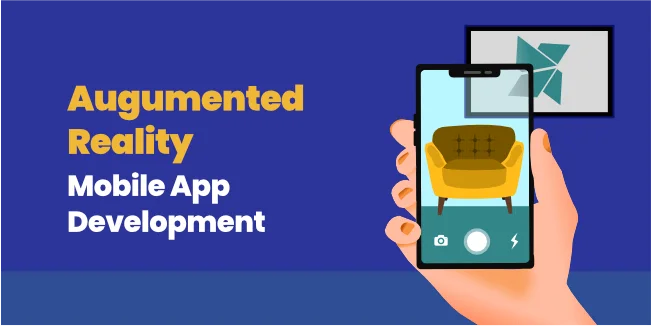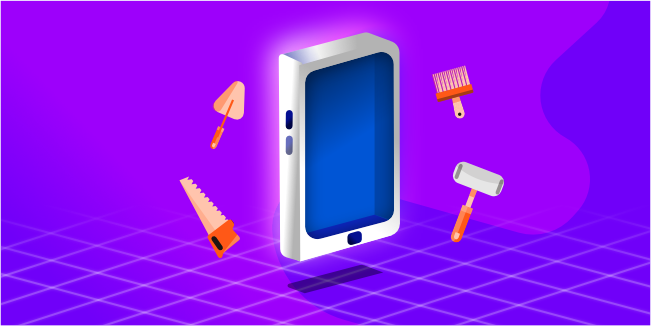Mobile Development
Business
mobileapp
appdevelopment
augumentedreality
Augmented Reality Mobile App Development - Complete Guide

Augmented reality, which is a relatively new technology, is gaining momentum. Countless businesses have been launched around it. Pokémon Go is an excellent example of how augmented reality has been used to create billions in value.
As mobile app development specialists, we have noticed a tremendous increase in AR application development. The market is demanding the use of this technology, so it is no wonder that Augmented Reality apps pay for themselves perfectly.
It is crucial because it explains your app's purpose and how your firm makes money. You're probably wondering how to create an augmented reality app or add such a feature to your program. This article is a comprehensive guide to developing augmented reality applications, covering all process stages.
Let's figure out how to develop an augmented reality app that will be popular in the future.
Augmented Reality - What It Is?
Augmented reality connects the virtual and real worlds by superimposing computer-generated images on a user's view of reality. It must have the following three features: Combine real-world and virtual data in real-time, be interactive in real-time (a change in the physical world necessitates a transformation of the virtual data), and "See" the world around us in 3D (because we exist in three-dimensional space). Do not confuse augmented and virtual reality.
End-users have already started to embrace AR. All they need is a smartphone with a camera to enjoy AR. Pokémon Go, IKEA Place, Sephora, and many other services are examples of such solutions. cloud recognition.
Another technology that frequently gets mixed up with augmented reality is virtual reality. While their aims may be similar, they are quite different.
2D or 3D items are imaged into real-life settings using AR technologies. With VR headsets or glasses, virtual reality creates a virtual world where users may submerge themselves
Augmented Reality App Development Types

Depending on what you want your augmented reality app to do, there are various types of development for it. Let's explore the main types:
- Marker-based augmented reality
- Location-based augmented reality
- Projection augmented reality
- Superimposition-based augmented reality
- Outlining augmented reality
The section below explores their differences and the technologies used to build each.
Marker-Based AR App
AR applications use image recognition or markers to detect images and objects. When the app recognizes an object, it then displays digital information on top of it.
The basic idea is to use QR codes and 3D or non-3D items as identifiers.
Location-Based AR App
People use GPS, accelerometers, and digital compasses in location-based AR apps to discover their location and create augmented reality objects. Aside from using these apps like maps, they can also help you discover exciting places to visit nearby or that you have searched for. They can also give you more information and facts about a particular place which is helpful for tourists and people who travel around the world.
Projection AR App
This application collects data from multiple sensors to identify an object's exact location, relying on visual odometry. It then uses complex algorithms to determine what action it should take next.
Projection AR may be used in car parking systems since it can reveal unavailable items from inside vehicle cameras. Architects and engineers can also use this technology to better understand the environment before building projects.
Superimposition-Based AR App
Superimposition-based AR technology is becoming increasingly popular in the healthcare industry. Doctors use this app to superimpose views of a patient's bones, tissues, muscles, and organs to understand the damage better and provide timely treatment. The military also uses this technology to help soldiers quickly see important objects and targets.
Outlining AR App
Architects, engineers, and car enthusiasts are using AR more frequently, which is helpful in several ways. For example, when driving, augmented reality technology can help you see things that ordinarily would only be visible through a rear-view mirror. It comes in handy, especially when parking. Outlining future construction sites is also made easier with AR since there is no longer a need to draw everything out on paper; instead, you can use sensors and cameras to do the work for you.
How to Develop an Augmented Reality App?

In fact, developing applications with AR technology is not much different from traditional native mobile app development. That is why we, as an offshore outsourcing company with over 12 years of experience creating mobile apps, know this process very well. Here are the most critical steps in creating an AR technology-based app:
- Product Discovery
- Market Research
- Choosing an SDK
- Target Research
- Development Stage
- Publishing
So let's expand on each of these stages.
Product Discovery
To put it another way, product discovery is the process of understanding customers on a deeper level to develop goods that match their needs.
Discovery is unquestionably the most challenging yet crucial stage in your software development lifecycle. We call this "product discovery," and it's often the most difficult stage in the software development process.
You can read more about product discovery and what it consists of, and why it is worth getting to know your idea at the beginning of the article "What is the Product Discovery and Product Discovery Process?" on our blog.
Market Research
To create a product for the local market, you must first research what kinds of applications are popular in that area. Doing so will give you an understanding of which type of product would be most successful.
One of the basic elements of market research is understanding costs. Thanks to this, we will be able to predict the possible costs of our project more accurately. To bring this subject closer, we have created an article, "How to create a project budget?" in which we thoroughly delve into the subject of the project budget to clarify this matter as much as possible.
It is worth adding that the discovery of the project budget is one of the stages of our "Discovery Workshop" training courses, i.e., studies that will prepare you and, together with our help, create your project from scratch.
Choosing Augmented Reality SDK
You can't just create an augmented reality project without considering essential factors, such as what your goals are for the project, your management style, and, most importantly, the tech stack of the app. It is also important to note the following:
- Native AR tools support
- Operating platform
- Programming language
- Future AR app updates
- Monetization concept and licenses
With cloud recognition, your mobile app can identify markers without storing much information on the device.
You'll be able to figure out exactly how much money you'll need to develop many AR apps once you've completed this lesson.
Target Research
As a Product Manager, you are highly familiar with your product's assumptions. To increase user engagement, it's time to conduct user research through customer interviews and focus groups. Additionally, validate any user experience insights from product analytics data.
Before beginning work, we discuss the problem from all angles. After that, research is conducted to verify our assumptions and better understand the data.
User feedback is essential for software development companies to create products that resonate with users. Interviews, observation studies, surveys, and industry analyses are conducted to collect this feedback. It allows teams to understand the needs of their user base and build better products.
Development Stage
The most important secret to successful apps is working with a trustworthy tech firm that may design an augmented reality app. You may view the steps below to see how to make the best decision, so don't miss them. Find a firm providing augmented reality app creation services by utilizing platforms like Clutch, The Manifest, and others.
Prior experience and professionalism should take precedence over price. Check clients' feedback before choosing firms. Examine the knowledge of vendors and compare it to that of other companies. Get in touch with shortlisted businesses for an interview. Decide on your future augmented reality app developers like mDevelopers.
Publishing
You can begin working on your marketing strategy while the product is still developing. The objective is to arouse curiosity about your business among your target audience through various marketing methods.
Start collecting client feedback as soon as your application goes on the market to learn what people think about it and how it can be improved. After you've had a chance to examine all the options, discuss them with your development team and see whether they can make any further improvements in future updates.
Augmented Reality Development Tools for Mobile Apps

AR app development is not an easy task. It's impossible to determine how to create an augmented reality app without knowing which technology options are available.
SDKs for developing augmented reality applications are tools created to assist developers in building such apps more quickly and without using components supplied by other businesses.
Let's go over some augmented reality development tools that will make your application more reliable.
With this extensive background knowledge of SDKs, you will be able to find an affordable solution that also won't hinder your augmented reality app development process.
Vuforia
Vuforia provides app developers and businesses with mobile-centric and immersive augmented reality experiences. The Vuforia SDK can identify and track image targets and 3D objects in real time, allowing businesses to orient and place virtual objects, 3D models, and various contents in relation to the real-world environment.
Aside from all that, Vuforia AR SDK can recognize multiple objects at once, support text recognition, and even provide a wide range of vocabulary. It also allows the creation of customized VuMarks, turns static images into full-motion videos, provides Unity Plugin, and supports cloud and local storage on devices used.
Wikitude
This product was created to help developers of augmented reality apps create location-centric AR experiences for users. It has since expanded to include geolocation, tracking, smart glasses, and image recognition using SLAM (Simultaneous Localization and Mapping) technology.
Currently, Wikitude is one of the most popular augmented reality mobile app development SDKs available.
Google ARCore
With three powerful features that aim to help developers blend the virtual world with reality by measuring real-world lighting conditions, detecting size, location, and angles of objects, and motion tracking, it's no wonder Google ARCore is considered one of the best-augmented reality development platforms. These features work together to create a realistic and engaging augmented reality experience for users.
Apple ARKit
Apple ARKit is a framework for creating augmented reality (AR) apps. It allows the mixing real and virtual objects and digital information while maintaining precision in tracking the physical world. Visual Inertial Odometry is included in Apple ARKit, which gives accurate geolocation of the real-world environment.
It combines face tracking and expression imitation, light tracking, angle tracking, 2D object detection, and integration with third-party tools like Unity and Unreal Engine into a single device.
Maxst
Maxst offers a variety of features, including visual Simultaneous Localization and Mapping (SLAM), perfect for mapping and tracking. Maxst is also capable of QR and barcode scanning, image tracking, and Unity plugin integration.
Kudan
Kudan's SDK engine was developed to handle marker-based and markerless location and tracking requirements. It has architecture-specific optimization to provide quick operational performance with seamless operation from specialist VPU to embedded in a chipset. With Kudan, you can make your augmented reality app development process efficient and swift.
Conclusion
Finally, augmented reality has a broader scope and practical use than virtual reality. Statista predicts that the augmented reality application development industry will reach $160 billion by 2023. AR is one of the most promising and rapidly growing industries, especially for mobile app developers. In the next 5 years, AR is expected to generate a higher revenue than any other industry. However, businesses must understand that developing successful AR applications requires time and money. It can be challenging, but it's lucrative and life-changing.